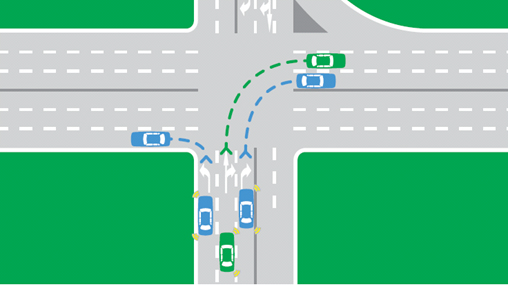Road rules in NT
Road markings
Painted arrows
Arrows are painted on the road to tell you which direction must be taken by traffic in each lane. When more than one direction is shown, you may go in the direction of either arrow.

You must signal that you are going to turn even if the lane you are in is only allowed to turn in one direction. When you turn, stay in the same lane as you move from one road to the other.
Dividing lines
Unless a sign tells you otherwise, you can cross any type of dividing line when:
- turning right at an intersection or
- to park in angle parking on the opposite side of the road.
Rule for overtaking and road markings
Do not make a U-turn across any single unbroken line or double dividing lines.

Broken white dividing lines – can be crossed to overtake if the road ahead is clear.

Double white lines with a broken line closer to you – you can cross the lines to overtake if the road ahead is clear.

Double white lines with an unbroken (continuous) line closer to you – you cannot overtake across these lines unless you are overtaking a cyclist.

Single white unbroken (continuous) line – you cannot overtake across this line unless you are overtaking a cyclist.

Double white unbroken (continuous) lines – you cannot overtake across these lines unless you are overtaking a cyclist.
When overtaking a cyclist, you must leave:
- a minimum distance of one metre when passing a cyclist in a 60km/h or less speed zone or
- 1.5 metres when the speed limit is over 60km/h.
Painted islands
You must not drive on a section of painted road that is surrounded by double lines.
You can drive on a painted island that is surrounded by single continuous or broken lines for up to 50m to enter or leave the road, or to enter a turning lane that begins immediately after the painted island.

You must not drive on areas surrounded by double lines.
When you enter a turning lane from a painted island you must give way to any vehicle already in the turning lane or entering the turning lane from another marked lane.
You must not stop on a painted island.
You can drive on a painted island regardless of the type of lines around the island in some instances such as:
- giving way to emergency vehicles
- when avoiding an obstruction
- overtaking a cyclist.

Car B must give way to car A (giving way to a vehicle already in the turning lane or entering from another marked lane).
Keep Clear pavement marking
You must not stop between the lines marked across the road. 'Keep Clear' pavement markings may also be used at some T-intersections to prevent queuing across the intersection.

Edge lines
You can drive on, across or outside edge lines for up to 100m only if you are doing one of the following:
- stopping
- overtaking on the inside of vehicles turning right or, in a one way street, overtaking vehicles turning left
- turning off or onto the road by the shortest route
- turning left or right at intersections.
- driving a slow moving vehicle.
Audible lines
Audible lines are lines composed of a series of raised pieces of material that create a noise or vibration if driven on by a vehicle.
These lines are used to warn you that you have veered outside your lane.
Kerb lines
These are yellow lines painted near the edge of the road show that there are stopping restrictions and tell you what rules apply to that particular section of road.
Broken yellow kerb line
A broken yellow kerb line is a clearway line.
You must not stop at the edge of the road between the hours shown on the 'Clearway' sign except in a medical or similar emergency.
Buses, taxis and hire cars can only stop to pick up or set down passengers.
Merging lanes
If the line ends before the lanes merge, the vehicle behind must give way to the vehicle in front.
When the lane ends and you have to cross the lines to merge, you must give way.

Car B gives way to car A.
Unbroken (continuous) yellow kerb line
An unbroken yellow kerb line is a 'No Stopping' line.
You must not stop for any reason except a medical or similar emergency.

Car A gives way to car B.
Print all pages in this section
Give feedback about this page.
Share this page:
URL copied!
